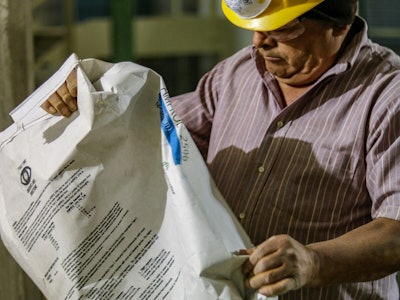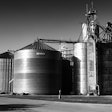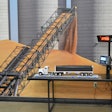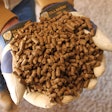
One of the first lessons I learned as a commercial nutritionist working at a feed mill, in Iowa, was that mycomputer-generated formulaswere not transferred 100% on production formulas.
This is a frequent issue, even with veteran nutritionist — often working as consultants — who forget to consider theability of each feed mill to measure accuratelyeach quantity prescribed in a feed optimization formula.
The case of adding corn
Here is a common example. Mostanimal feed formulasbalance on corn — that is, after all ingredients are accounted for at the required amount, the remainder is rounded up to 100% by adding corn. So one formula may contain, let’s say, 1,005.3 pounds of corn per 2,000-pound ton.
In my experience, very few (large and/or sophisticated) feed mills can accurately weight 5.3 pounds of corn as the equipment used is often within the 5- to 10-pound error range. That means each step in adding more corn can end up 5 to 10 pounds different as automation is not always precise nor accurate, and such large volume ingredients are not added by hand.
Some highly automated systems have the capacity to learn how each raw material behaves so that they keep correcting the final difference (for example, from the time the auger stops until the last kernel of corn hits the scale there is a time-weight gap). However, with each new batch of corn (or any other grain) this learning curve starts anew as dry matter affects the behavior of each raw material.
How to correctly hand-add micro-ingredients
Another common example, especially in small feed mills, is the micro-ingredients that are added by hand. If a nutritionist designs a formula that calls for, say, 1.15 pounds of L-threonine, but the actual scale has a sensitivity of 0.1 pound, then it is practically impossible to account accurately for that 5/100th’sof a pound difference.
In addition, a nutritionist should also try to minimize the factor of human error before the formulas reach the production floor. For example, the worker who adds by hand all these micro-ingredients will be less prone to errors if the quantities are rounded up or down to reasonable amounts, even if the scale has such minute sensitivity.
If a formula contains 10 micro-ingredients and the worker needs to prepare 100 such micro-batches per day, then each step towards simplifying the process will also minimize the possibility of a major error. It is not unheard of to misplace the decimal point and instead of 11.11 pounds of L-lysine to add 1.111, and so on.
Balancemiddle-level raw materials like fish meal
There is also a middle area where some ingredients are not utilized at volumes large enough to justify their own automated bin, but again, the amount per ton is quite significant.
Such an example is fish meal. Most complete formulas that contain fish meal have an inclusion rate between 2.5% to 5.0%. In practical terms, this translates from one to two standard bags (each with 50 pounds of fish meal) per ton.
It makes little sense, and causes much chagrin at the feed mill level, to have to weigh 22 or 47 pounds of fish meal. And, from a nutritional point of view, we know that such difference between 22 and 25 or 47 and 50 pounds of fish meal are relatively insignificant from the animal’s perspective. So, it pays to know how these specialty ingredients come to the feed mill and adjust inclusion levels accordingly.
Reason behind ingredient discrepancies
One reasonable question to ask is why nutritionists do not consider such details, which are often corrected by the feed mill manager. The reason is quite simple. Feed products are not likely formulated by computer software programs to meet specific nutrient levels.
There are a few exceptions for ingredients with no accountable nutritional value that enter formulas at predetermined fixed value (for example, a prebiotic added at 2 pounds/ton as instructed by its supplier). But most raw materials are formulated to meet exact nutrient specifications resulting in bizarre final inclusion levels.
Here is another example. Say, the nutritionist formulates a feed with 1.0 total lysine as a nutrient (a simple example) and set a maximum limit of 0.3% on feed-grade lysine as a raw material (for example L-Lysine HCL). If the only other major source of lysine is soybean meal, it is unavoidable (in almost all cases) for the feed formulation program to end up with a round amount for soybean meal. So, if 6 pounds/ton of L-Lysine HCl are used and only corn and soybean meal (say 44% crude protein) are available, then the amounts for corn and soybean meal will be 1,881 and 116 pounds/ton, respectively, ignoring any other ingredients that usually exist in a feed for the sake of simplicity in our example.
Now, in practice, the feed-grade lysine will be added at 6 pounds by hand, but at best we will have 1,880±5 and 110±5 pounds of corn and soybean meal being added by the automated system. Not a huge difference, but not exactly the formula the nutritionist designed to begin with.
Formulate feed for specific feed mill abilities
Modern feed mills can take a feed formulation from the nutritionist and adjust it automatically to specific feed mill abilities. As mentioned before, this was already done and continues to be done in small mills by the feed mill managers.
But this does not need to be the case, as it is best for the nutritionist to have a crystal-clear picture of what is being produced. This might help in case problems arise in the future.
For example, a small deviation from the prescribed amount of calcium carbonate in a layer formula may end up causing excess numbers of broken eggshells (if less) or liver damage (if more) — and in any other formula calcium carbonate is often being used as a filler with relative impunity!
So, modern feed formulation programs already have the code installed to account for feed mill abilities. These are figures that are entered once, and then the program formulates to meet nutrients based on raw material predetermined steps. For that, some minor flexibility in nutrient specifications might be necessary.
In closing, I would like to mention one more cause of distress between nutritionists and feed mills. A formula that calls for 2.5 pounds of wheat/ton (just because wheat is available at the mill) to meet the least-cost criterion is of very little if any significance to cost or animal performance. But it makes a big difference during production of said formula for the feed mill personnel.





















